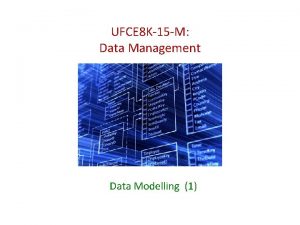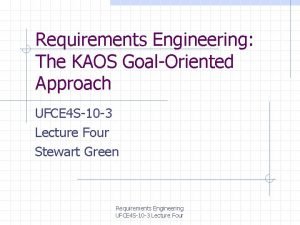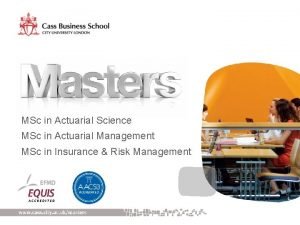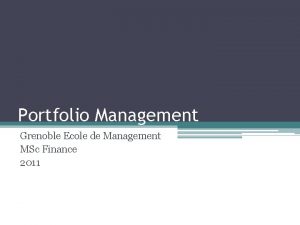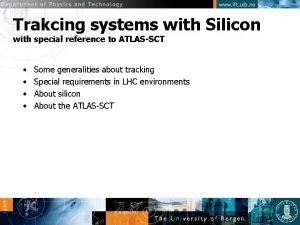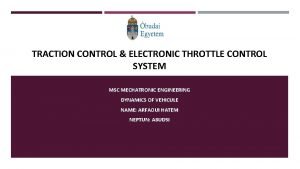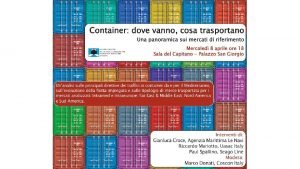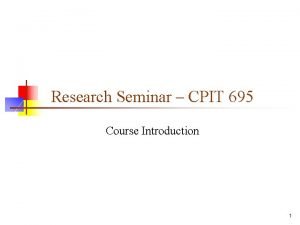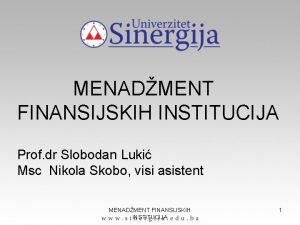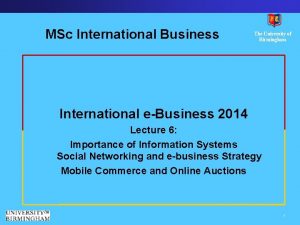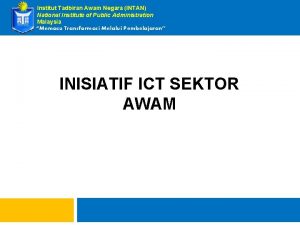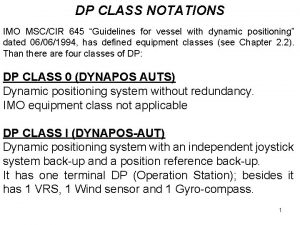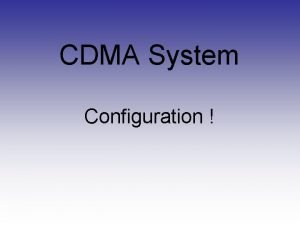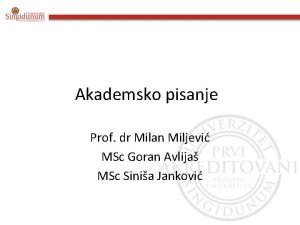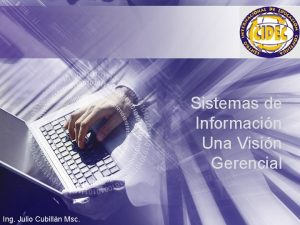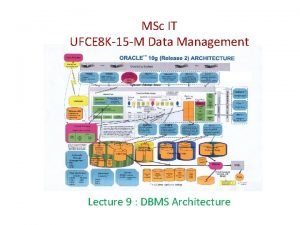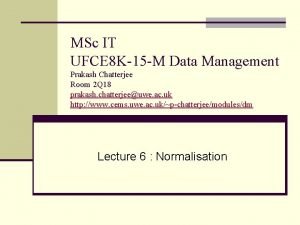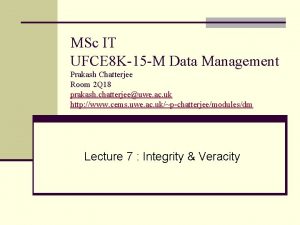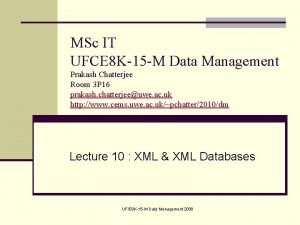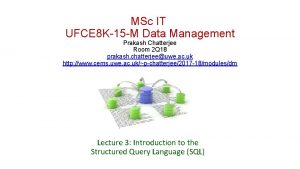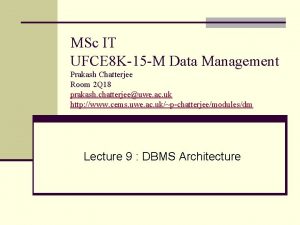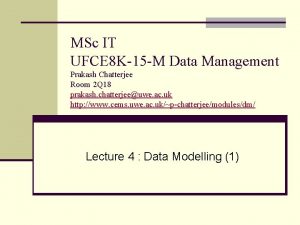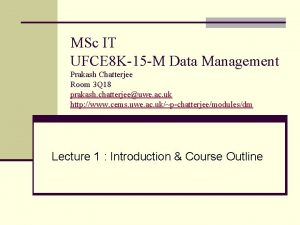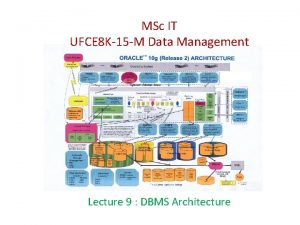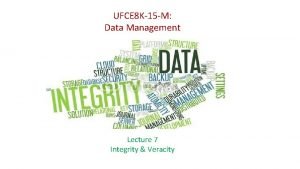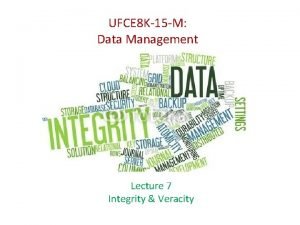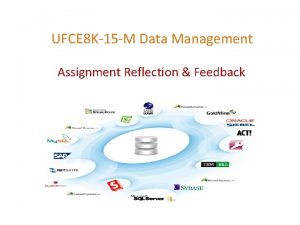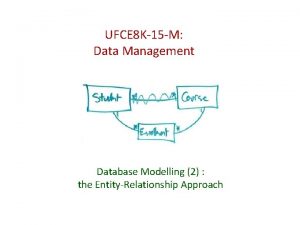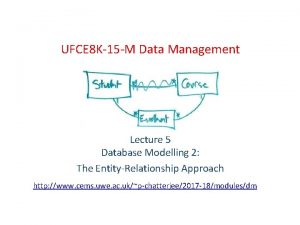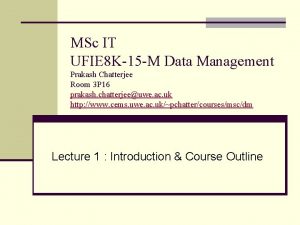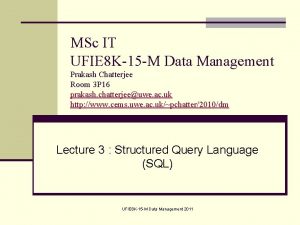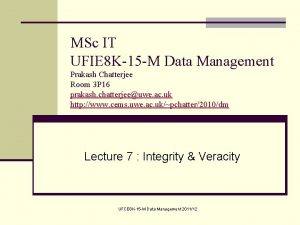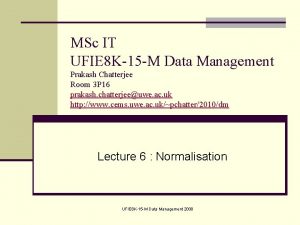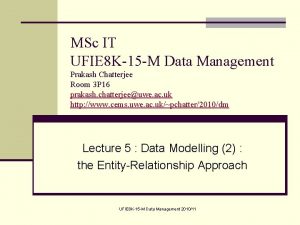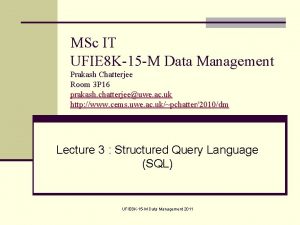MSc IT UFCE 8 K15 M Data Management






















- Slides: 22

MSc IT UFCE 8 K-15 -M Data Management Prakash Chatterjee Room 3 P 16 prakash. chatterjee@uwe. ac. uk http: //www. cems. uwe. ac. uk/~p-chatterjee/modules/dm Lecture 2 : The Relational Data Model

Origins of the Relational Model n The relational model was developed by EF Codd in the early 1970 s. n Commercial systems based on the relational model appeared in the late 1970 s. n At present there are several hundred relational DBMSs and most computer vendors support 'relational' software. n Examples of well-known products include Oracle, DB 2, Sybase, My. SQL, MS. SQL Server and MS Access. Informally, a relational system is a system in which: 1. The data is perceived by the user as tables (and nothing but tables). 2. The operators available to the user for (e. g. ) retrieval are operators that derive “new” tables from "old" ones. For example, there is one operator, restrict, which extract a subset of the rows of a given table, and another, project, which extracts a subset of columns - and a row subset and a column subset of a table can both be regarded in turn as tables in their own right. UCE 8 K 15 -M Data Management 2012/13

Components and terminology (1) The model uses terminology taken from mathematics, particularly set theory and predicate logic. Basic terminology used in relational theory includes: n relation - this corresponds to a table or flat file with columns and rows n tuple - a row of a relation n attribute - a named column of a relation n domain - the set of allowable values for one or more attributes n degree of a relation - the number of attributes it contains n cardinality of relation - the number of tuples it contains. UCE 8 K 15 -M Data Management 2012/13

Components and terminology (2) UCE 8 K 15 -M Data Management 2012/13

Properties of relations n There is only one data structure in the relational data model - the relation. n Every relation and every attribute within a relation must have a distinct name. n Attribute (column) values of a relation are atomic (i. e. single valued). n All values in an attribute (column) are taken from same domain. n The ordering of columns in a relation is not significant. n Duplicate tuples (rows) are not allowed (e. g. each row in a relation must be distinct). n The ordering of tuples (rows) and attributes (columns) is not significant. UCE 8 K 15 -M Data Management 2012/13

Relational algebra & relational calculus n Relational algebra (ra) and relational calculus (rc) are both formal (mathematically based) languages defined by EF Codd. n ra & rc are logically equivalent languages. ra is “procedural” and rc is “declarative” in nature. n ra and rc are the formal grounding of the relational database model and illustrate the basic operations required by any data manipulation language such as SQL. n Relational algebra is an offshoot of first-order logic, is a set of relations closed under operators. Operators operate on one or more relations to yield a relation. n The “closure” property relates to the fact that from any given relational operation another relation is output - it os often refereed to as the “relations in – relations out” property. UCE 8 K 15 -M Data Management 2012/13

Relational algebra operators (1) n Each relational operator takes one or more relations as its input and produces a new relation as output (closure). Codd originally defined eight operators, in two classes: Set operators: The special relational operators: UNION INTERSECTION DIFFERENCE DIVIDE RESTRICT PROJECT JOIN Cartesian PRODUCT UCE 8 K 15 -M Data Management 2012/13

Relational algebra operators (2) UCE 8 K 15 -M Data Management 2012/13

Relational algebra operators (3) dept – emp – salgrade example (1) n dept – emp – salgrade example Department : dept (depno, dname, location) Employee : emp (empno, ename, mgr, sal, deptno) Salary Grade : salgrade (grade, losal, hisal) UCE 8 K 15 -M Data Management 2012/13

Relational algebra operators (4) dept – emp – salgrade example (2) n dept table deptno dname location 10 Accounting New York 20 Research Dallas 30 Sales Chicago 40 Operations Boston UCE 8 K 15 -M Data Management 2012/13

Relational algebra operators (5) dept – emp – salgrade example (3) n emp table empno ename mgr sal deptno 7369 SMITH 7902 £ 800. 00 20 7499 ALLEN 7698 £ 1, 600. 00 30 7521 WARD 7698 £ 1, 250. 00 30 7566 JONES 7839 £ 2, 975. 00 20 7654 MARTIN 7698 £ 1, 250. 00 30 7698 BLAKE 7839 £ 2, 850. 00 30 7782 CLARK 7839 £ 2, 450. 00 10 7788 SCOTT 7566 £ 3, 000. 00 20 7839 KING £ 5, 000. 00 10 7844 TURNER 7698 £ 1, 500. 00 30 7876 ADAMS 7788 £ 1, 100. 00 20 7900 JAMES 7698 £ 950. 00 30 7902 FORD 7566 £ 3, 000. 00 20 7934 MILLER 7782 £ 1, 300. 00 10 UCE 8 K 15 -M Data Management 2012/13

Relational algebra operators (6) dept – emp – salgrade example (4) n salgrade table grade losal hisal 1 £ 700. 00 £ 1, 200. 00 2 £ 1, 201. 00 £ 1, 400. 00 3 £ 1, 401. 00 £ 2, 000. 00 4 £ 2, 001. 00 £ 3, 000. 00 5 £ 3, 001. 00 £ 99, 999. 00 UCE 8 K 15 -M Data Management 2012/13

Relational algebra operators (7) dept – emp – salgrade example (5) n Restrict Subset of the Rows in a Table RESTRICT EMP WHERE sal > 2000 empno ename mgr sal deptno 7566 JONES 7839 £ 2, 975. 00 20 7698 BLAKE 7839 £ 2, 850. 00 30 7782 CLARK 7839 £ 2, 450. 00 10 7788 SCOTT 7566 £ 3, 000. 00 20 7839 KING £ 5, 000. 00 10 7902 FORD £ 3, 000. 00 20 7566 UCE 8 K 15 -M Data Management 2012/13

Relational algebra operators (8) dept – emp – salgrade example (6) n Project subset the Columns in a Table PROJECT EMP [EMPNO, SAL, DEPTNO] empno sal deptno 7369 £ 800. 00 20 7499 £ 1, 600. 00 30 7521 £ 1, 250. 00 30 7566 £ 2, 975. 00 20 7654 £ 1, 250. 00 30 7698 £ 2, 850. 00 30 7782 £ 2, 450. 00 10 7788 £ 3, 000. 00 20 7839 £ 5, 000. 00 10 7844 £ 1, 500. 00 30 7876 £ 1, 100. 00 20 7900 £ 950. 00 30 7902 £ 3, 000. 00 20 7934 £ 1, 300. 00 10 UCE 8 K 15 -M Data Management 2012/13

Relational algebra operators (9) dept – emp – salgrade example (7) n Restrict-Project RESTRICT EMP WHERE SAL >2000 PROJECT EMP[EMPNO, SAL, DEPTNO] empno sal deptno 7566 £ 2, 975. 00 20 7698 £ 2, 850. 00 30 7782 £ 2, 450. 00 10 7788 £ 3, 000. 00 20 7839 £ 5, 000. 00 10 7902 £ 3, 000. 00 20 call this EMPX Could you reverse these operations - always? ( project then restrict? ) UCE 8 K 15 -M Data Management 2012/13

Relational algebra operators (10) dept – emp – salgrade example (8) n Product combine each row of one table with each row of the other PRODUCT DEPT with EMPX empno sal EMPX. deptno dept. Depno dname loc 7566 £ 2, 975. 00 20 10 Accounting New York 7698 £ 2, 850. 00 30 10 Accounting New York 7782 £ 2, 450. 00 10 10 Accounting New York 7788 £ 3, 000. 00 20 10 Accounting New York 7839 £ 5, 000. 00 10 10 Accounting New York 7902 £ 3, 000. 00 20 10 Accounting New York 7566 £ 2, 975. 00 20 20 Research Dallas 7698 £ 2, 850. 00 30 20 Research Dallas 7782 £ 2, 450. 00 10 20 Research Dallas 7788 £ 3, 000. 00 20 20 Research Dallas 7839 £ 5, 000. 00 10 20 Research Dallas 7902 £ 3, 000. 00 20 20 Research Dallas UCE 8 K 15 -M Data Management 2012/13

Relational algebra operators (11) dept – emp – salgrade example (9) 7566 £ 2, 975. 00 20 30 Sales Chicago 7698 £ 2, 850. 00 30 30 Sales Chicago 7782 £ 2, 450. 00 10 30 Sales Chicago 7788 £ 3, 000. 00 20 30 Sales Chicago 7839 £ 5, 000. 00 10 30 Sales Chicago 7902 £ 3, 000. 00 20 30 Sales Chicago 7566 £ 2, 975. 00 20 40 Operations Boston 7698 £ 2, 850. 00 30 40 Operations Boston 7782 £ 2, 450. 00 10 40 Operations Boston 7788 £ 3, 000. 00 20 40 Operations Boston 7839 £ 5, 000. 00 10 40 Operations Boston 7902 £ 3, 000. 00 20 40 Operations Boston UCE 8 K 15 -M Data Management 2012/13

Relational algebra operators (12) dept – emp – salgrade example (10) n Product (Cartesian product) DEPT has 4 records EMPX has 6 records so DEPT x EMPX has 24 records but not very useful UCE 8 K 15 -M Data Management 2012/13

Relational algebra operators (13) dept – emp – salgrade example (11) n Equi-Join product restricted to rows which have matching common domain empno sal EMPX. deptno dname loc 7566 £ 2, 975. 00 20 20 Research Dallas 7698 £ 2, 850. 00 30 30 Sales Chicago 7782 £ 2, 450. 00 10 10 Accounting New York 7788 £ 3, 000. 00 20 20 Research Dallas 7839 £ 5, 000. 00 10 10 Accounting New York 7902 £ 3, 000. 00 20 20 Research Dallas UCE 8 K 15 -M Data Management 2012/13

Relational algebra operators (14) dept – emp – salgrade example (12) n Natural Join equi-join projected with the duplicate column removed empno sal deptno dname loc 7566 £ 2, 975. 00 20 Research Dallas 7698 £ 2, 850. 00 30 Sales Chicago 7782 £ 2, 450. 00 10 Accounting New York 7788 £ 3, 000. 00 20 Research Dallas 7839 £ 5, 000. 00 10 Accounting New York 7902 £ 3, 000. 00 20 Research Dallas UCE 8 K 15 -M Data Management 2012/13

Basic SQL n SELECT * FROM EMP WHERE SAL > 2000; n SELECT ENAME, SAL, DEPTNO FROM EMP WHERE SAL > 2000; n SELECT * FROM EMP, DEPT WHERE SAL > 2000 AND EMP. DEPTNO = DEPTNO; n SELECT EMPNO, SAL, DEPTNO, DNAME FROM EMP, DEPT WHERE SAL > 2000 AND EMP. DEPTNO = DEPTNO; UCE 8 K 15 -M Data Management 2012/13

Bibliography / Readings / Home based activities Bibliography - An Introduction to Database Systems (8 th ed. ), C J Date, Addison Wesley 2004 Database Management Systems, P Ward & G Defoulas, Thomson 2006 Readings - Introduction to SQL’ Mc. Graw-Hill/Osbourne (handout) Home based activities - Ensure you download xampp and install on home PC or laptop (if you have a slow home internet connection – download to data key or CD here at UWE) Copy the SQL Workbook onto your data key or CD. Import the tables from the SQL Workbook into your home My. SQL DB. Begin working through some of the query examples in the workbook using PHPMy. Admin. UCE 8 K 15 -M Data Management 2012/13
 Ufce
Ufce Ufce
Ufce Msc actuarial management
Msc actuarial management Grenoble ecole de management msc finance
Grenoble ecole de management msc finance Msc trakcing
Msc trakcing Msc traction
Msc traction Stretto di gibilterra larghezza
Stretto di gibilterra larghezza Cpit courses
Cpit courses Almacenes msc
Almacenes msc Prof msc
Prof msc University of birmingham msc international business
University of birmingham msc international business Jma msc
Jma msc 7 aplikasi perdana msc
7 aplikasi perdana msc Msc in construction law
Msc in construction law Msc sirkka
Msc sirkka Dp class
Dp class Network msc
Network msc Telecommunication systems book
Telecommunication systems book Msc eir
Msc eir Msc sandra
Msc sandra Prof msc
Prof msc 2vision msc
2vision msc Msc definition
Msc definition
